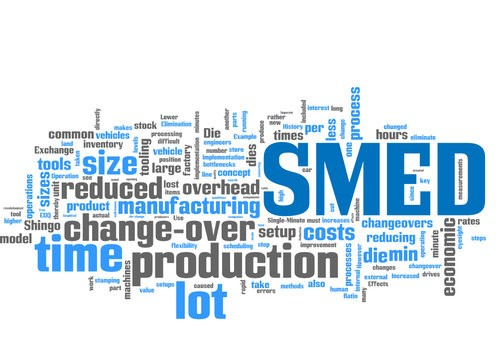
 Data Structure
Data Structure Networking
Networking RDBMS
RDBMS Operating System
Operating System Java
Java MS Excel
MS Excel iOS
iOS HTML
HTML CSS
CSS Android
Android Python
Python C Programming
C Programming C++
C++ C#
C# MongoDB
MongoDB MySQL
MySQL Javascript
Javascript PHP
PHP
- Selected Reading
- UPSC IAS Exams Notes
- Developer's Best Practices
- Questions and Answers
- Effective Resume Writing
- HR Interview Questions
- Computer Glossary
- Who is Who
How SMED Maximizes Productivity?
SMED reduces the changeover time between finishing one project to start another one. In this process, human brains, physical activities, and machine learning, collaboratively contribute to implementing it in reality. Our today's post will highlight how SMED increases productivity.
If you're new to learning or have heard the term for the first time, first let it clear that the SMED method can apply to any industry to increase productivity and lessen the waiting time in the queue. Let us clearly explain so that you can implement it in your workplace.
What is SMED?

The full form of SMED means Single Minute Exchange of Dies. Toyota engineer Shigeo Shingo coined the term in 1969 to introduce a method that can reduce the production time between two projects one after another.
Earlier in the manufacturing industry, especially the automobile sector encountered massive losses due to the time gap. Once a project had finished, it took time to start another one. On the contrary, the demand level was piling up, so the entire process was tossed up.
As a result, business growth couldn't streamline, and many companies encountered a loss for the demand-supply gap. So when Shigeo Shingo realized the reason behind the delay, he invented the SMED, the most practical method implemented in the automobile sector, and experienced a vast margin.
It's proven that when the time reduces from one series of the last function and the beginning of the second functional part, it affects the production, cost, and delivery of the ready products. So SMED is like, if you're into tailoring cloth materials, while you finish the stitching of the first lot, your second lot cutting will also be prepared so that the tailor master can start immediately after delivery of the first lot.
It's just an example of how the industry is working with adopting the SMED method.
The Benefits of SMED: Practical and Need of the Hour
Large scale industry or medium size, the SMED fetch a good margin for all the sectors that adopt the method. Below is the benefits list -
Fast Delivery - The first and foremost advantage of SMED is to speed up the manufacturing process. It helps to keep a balance between demand and supply.
Lower the Manufacturing Cost - Quick changeover time leads to less equipment downtime, which helps in reducing production costs.
More Responsive to Customer Demand - Shrink of changeover time also helps in responsiveness to customer demand while maintaining the delivery schedule.
Manage Inventory - Quick changeover and scheduled delivery lead to effective inventory management.
High-scale Productivity - Fast process with planned management helps inconsistency yet quality product delivery.
Reduces the Manufacturing damages - The shortening changeover time helps reduce the manufacturing damages as resources have a clear plan for what to do next with ready material.
Flexible in Product manufacturing - With SMED, large-size and small-size productions can make possible with equal flexibility and speed.
The SMED can roll out even industrial hazards effectively, and the production process can bypass sudden challenges. Thus, SMED, the technique, becomes a savior in many critical situations and helps maximize productivity. Additionally, it can prevent malfunctioning operations in the organization and reduce the changeover gap effectively.
How SMED Works?
To learn SMED functional value, first, you need to understand how it works. Here are the steps to implement the SMED and keep the balance with all the other departments.
Initial Stage of Planning
In the manufacturing units, it's the priority to plan everything. For example, an organization first checks the product details, resources available to finish the project, and how much raw materials will be needed to complete it on time.
However, SMED is not the first or primary priority, but the planning is. Manufacturing units plan the SMED once they get all the data and start further planning of production, delivery, and cost, and later comes a reduction of changeover time.
After finalizing the manufacturing planning with SMED, the production process starts to follow the steps to ensure smooth going -
Step 1: Pilot area Identification
In the identification part, the organization finds the pilot area to start. Equipment selection and deciding on the workforce is crucial in this step. Plan an effective changeover; it needs a balance between target equipment and the availability of resources. Here teamwork is also essential to materialize the plan.
Step 2: Locate the Elements
To materialize the changeover, the team needs to work together. A strong collaboration can sail the process. The team can further chalk out the elementary baseline -
Description of the Work
How the elements work to finish the project?
Here are a few valuable tips that can speed up the process -
Elements must be documented if 30 to 50 changeovers are planned.
Use sticky notes to jot down the series of the elements manpower will perform during the changeover.
Proper utilization of man and machine power to align the work, as human management can optimize and machine power can tweak.
A detailed observation can rectify the planning section's mistakes and reduce the errors in the process.
Sometimes allowing changeover with its usual rhythm is the only solution left with the organization; keep it going.
Step 3: Separation of External Elements
In this step, the elements of the changeover process run with the equipment are identified and calculated whether the changeover time is cut down halfway. However, in this step, the minimal change can be seen when it's completed while the equipment is running.
The external element is categorized following the below points -
Retrieval of pieces of machinery components like parts, tools, etc
Inspection of materials
Cleaning while the process is running
Quality checks for standard production
Therefore, from this step, the changeover elements can be classified into three sections: External Elements (before the changeover), Internal Elements (during the changeover), and External Elements (after the changeover).
Step 4: Conversion of Internal Elements to External
In this stage, the changeover process thoroughly examines and tries to convert many internal elements into external ones. Team of resources constantly striving to make the conversion process successful. Further, cost and benefit data are always under analysis for each candidate element in this step. Specific parameters are technically accepted to convert internal elements to external ones. These are -
Advanced Preparation
Modulation
Duplicate jigs
Modification
Step 5: Streamline and align the leftover Elements
It's the last process and therefore emphasizes streamlining the leftover elements to simplify the process in less time. In this step, of every component, the team should ask about reducing the time and simplifying the elements. In streamlining the leftover elements, it needs the technique to adopt that include:
Release of elements bolts
Adjustment with the alignment
Motion to reorganize the workspace
Reduce waiting
Standardized hardware
Operation working on parallel
Mechanize the efforts
These 5 SMED walk through let productivity be high and let the organization function at its highest peak, balancing between several projects and keeping consistent about the demand-supply chain. With a successful SMED implementation, an organization needs a perfect balance between workforce and machinery. It helps to continue the process and streamline the operation without delay as man and machine go hand-in-hand for the proper functions of manufacturing units.
Conclusion
The manufacturing industry, among all, experiences the side effects of lengthy change-over time; perhaps the industries face the ultimate challenge of delivering products on time. But the effective use of SMED in operation can minimize the loss of waiting hours, maximize productivity, and increase the marginal volume of business. However, there needs to be a balance between the plan and execution, especially when following SMED; the operation committee must be ready to do anything to smoothen the process, and there shouldn't be any waiting hours on the client's end.

